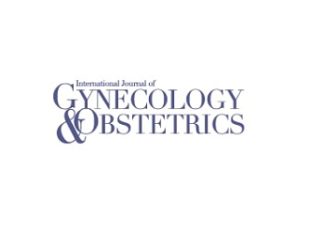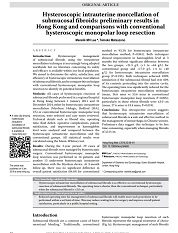Clinical Outcomes

Scheiber MD, Chen SH. J Gynecol Surg. 2016 Dec 1;32(6):318-323.
The objective of this study... Show more
Scheiber MD, Chen SH. J Gynecol Surg. 2016 Dec 1;32(6):318-323.
The objective of this study was to explore the feasibility of hysteroscopic morcellation across a diverse set of facilities, including both surgical and office-based settings.
Please visit PubMed for the full text article.

Epstein E, Ramirez A, Skoog L, Valentin L. Acta Obstet Gynecol Scand. 2001... Show more
Epstein E, Ramirez A, Skoog L, Valentin L. Acta Obstet Gynecol Scand. 2001 Dec;80(12):1131-6.
The objective of this study was to determine the prevalence of focally growing lesions in the uterine cavity in women with postmenopausal bleeding and endometrium > or = 5 mm and the extent to which such lesions can be correctly diagnosed by D&C.
Please visit PubMed for the full text article.

Harpham M, Abbott J. J Minim Invasive Gynecol. 2014 Nov-Dec;21(6):1118-20.
A case report of... Show more
Harpham M, Abbott J. J Minim Invasive Gynecol. 2014 Nov-Dec;21(6):1118-20.
A case report of a 24-year-old woman with recurrent miscarriages and recurrent intrauterine adhesions after treatment of non-progressive pregnancies. Targeted intrauterine pregnancy tissue removal using a hysteroscopic morcellator was performed to reduce the risk of adhesion recurrence. Successful removal of products of conception, without subsequent adhesion formation, and an ongoing viable pregnancy followed.
Please visit PubMed for the full text article.

Keriakos R, Khalid S. J Obstet Gynaecol. 2016 May;36(4):426-7.
The objective of this study... Show more
Keriakos R, Khalid S. J Obstet Gynaecol. 2016 May;36(4):426-7.
The objective of this study was to showcase surgical management of corneal ectopic pregnancy using hysteroscopic tissue removal.
Please visit PubMed for the full text article.

Munro MG. J Minim Invasive Gynecol. 2016 Jan;23(1):12-3.
The objective of this study was to... Show more
Munro MG. J Minim Invasive Gynecol. 2016 Jan;23(1):12-3.
The objective of this study was to demonstrate a technique designed to expand the capabilities of hysteroscopic intrauterine morcellators to deep type 1 and type 2 lesions. The technique comprises "release" of the tumor using a bipolar radiofrequency needle, followed by dissection and extraction with an electromechanical morcellator, all under local anesthesia.
Please visit PubMed for the full text article.

Dueholm M et al. Gynaecological Endoscopy (ESGE) 1998.
The objective of this study was to... Show more
Dueholm M et al. Gynaecological Endoscopy (ESGE) 1998.
The objective of this study was to assess regression of residual tissue after incomplete transcervical resection of myomas (TCRM), by transvaginal ultrasound examination with the use of saline infusion into the cavity (hysterosonographic examination; HSE).
Please visit PubMed for the full text article.

Van Dongen H, Emanuel MH, Smeets MJ, et al. Acta Obstet Gynecol Scand.... Show more
Van Dongen H, Emanuel MH, Smeets MJ, et al. Acta Obstet Gynecol Scand. 2006;85(12):1463-7.
This observational study analysed whether a period of wait and see was reasonable following incomplete removal of submucous fibroids, with regard to symptoms of abnormal uterine bleeding, and whether factors predicting subsequent surgery could be identified.
Please visit PubMed for the full text article.

Arnold A, Ketheeswaran A, Bhatti M, et al. J Minim Invasive Gynecol. 2016... Show more
Arnold A, Ketheeswaran A, Bhatti M, et al. J Minim Invasive Gynecol. 2016 Mar-Apr;23(3):435-41.
The objective of this study is to determine the effectiveness of the MyoSure intrauterine mechanical morcellator device for removal of intrauterine pathology.
Please visit PubMed for the full text article.

Liang Y, Ren Y, Wan Z, et al. Medicine (Baltimore). 2017 Dec;96(50):e9363.
This study aims... Show more
Liang Y, Ren Y, Wan Z, et al. Medicine (Baltimore). 2017 Dec;96(50):e9363.
This study aims to determine whether clinical evaluation of improved MyoSure hysteroscopic tissue removal system can remove type II submucosal myomas with safety and high success rate of the first operation.
Please visit PubMed for the full text article.

Shazly SA, Laughlin-Tommaso SK, Breitkopf DM, et al. J Minim Invasive Gynecol. 2016... Show more
Shazly SA, Laughlin-Tommaso SK, Breitkopf DM, et al. J Minim Invasive Gynecol. 2016 Sep-Oct;23(6):867-77.
This systematic review and meta-analysis compares hysteroscopic morcellation with electrosurgical resection to treat uterine cavitary lesions.
Please visit PubMed for the full text article.

Li C, Dai Z, Gong Y, Xie B, Wang B. Int J Gynaecol Obstet. 2017... Show more
Li C, Dai Z, Gong Y, Xie B, Wang B. Int J Gynaecol Obstet. 2017 Jan;136(1):6-12.
The objective of this study was to compare hysteroscopic morcellation with conventional resectoscopy for removal of endometrial lesions.
Please visit PubMed for the full text article.

Lee MM, Matsuzono T. 2016
Overview: Hysteroscopic management of submucosal fibroids using the... Show more
Lee MM, Matsuzono T. 2016
Overview: Hysteroscopic management of submucosal fibroids using the intrauterine morcellation technique is increasingly being adopted worldwide but no literature concerning its safety and efficacy is available within our local population. We aimed to determine the safety, satisfaction, and efficiency of hysteroscopic intrauterine morcellation of submucosal fibroids, and to compare this technique with conventional hysteroscopic monopolar loop resection to identify its potential benefits.
Please visit PubMed for the full text article.